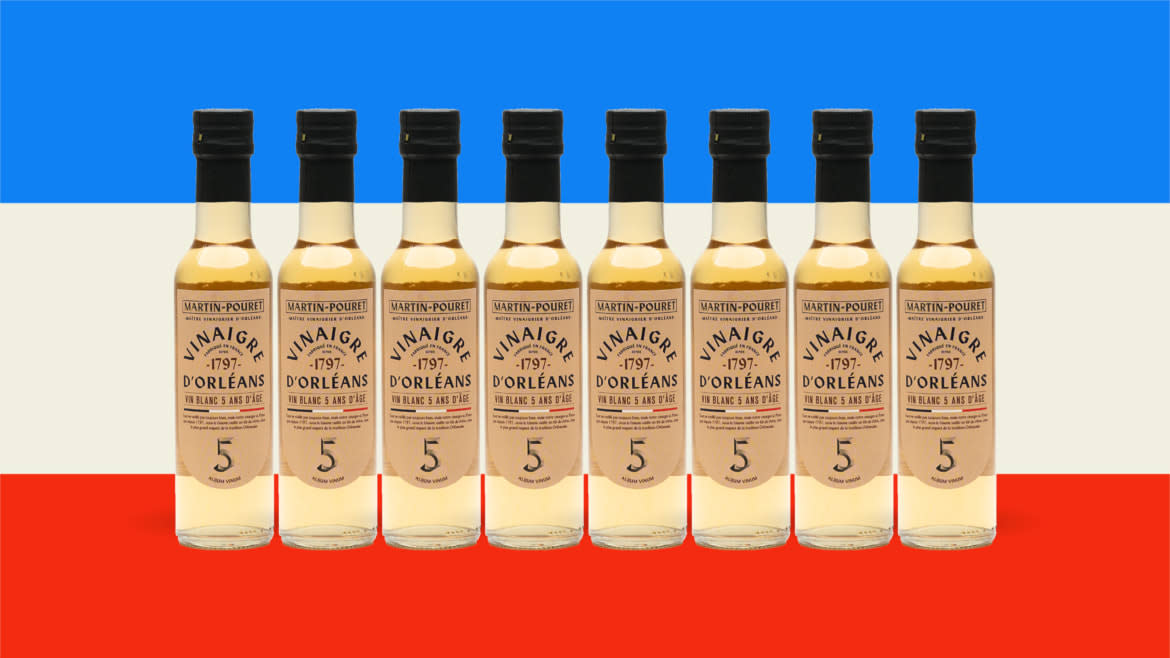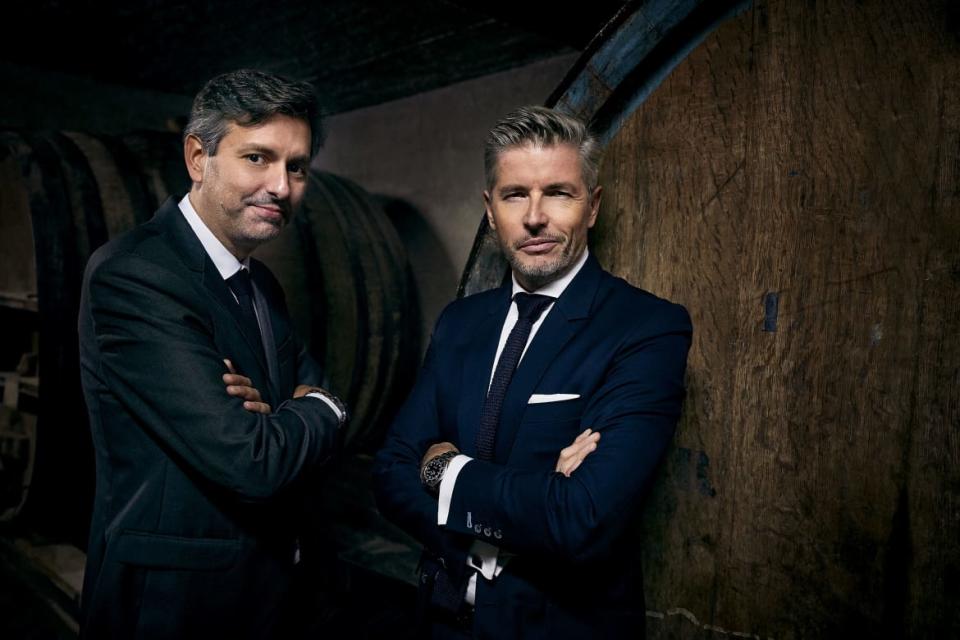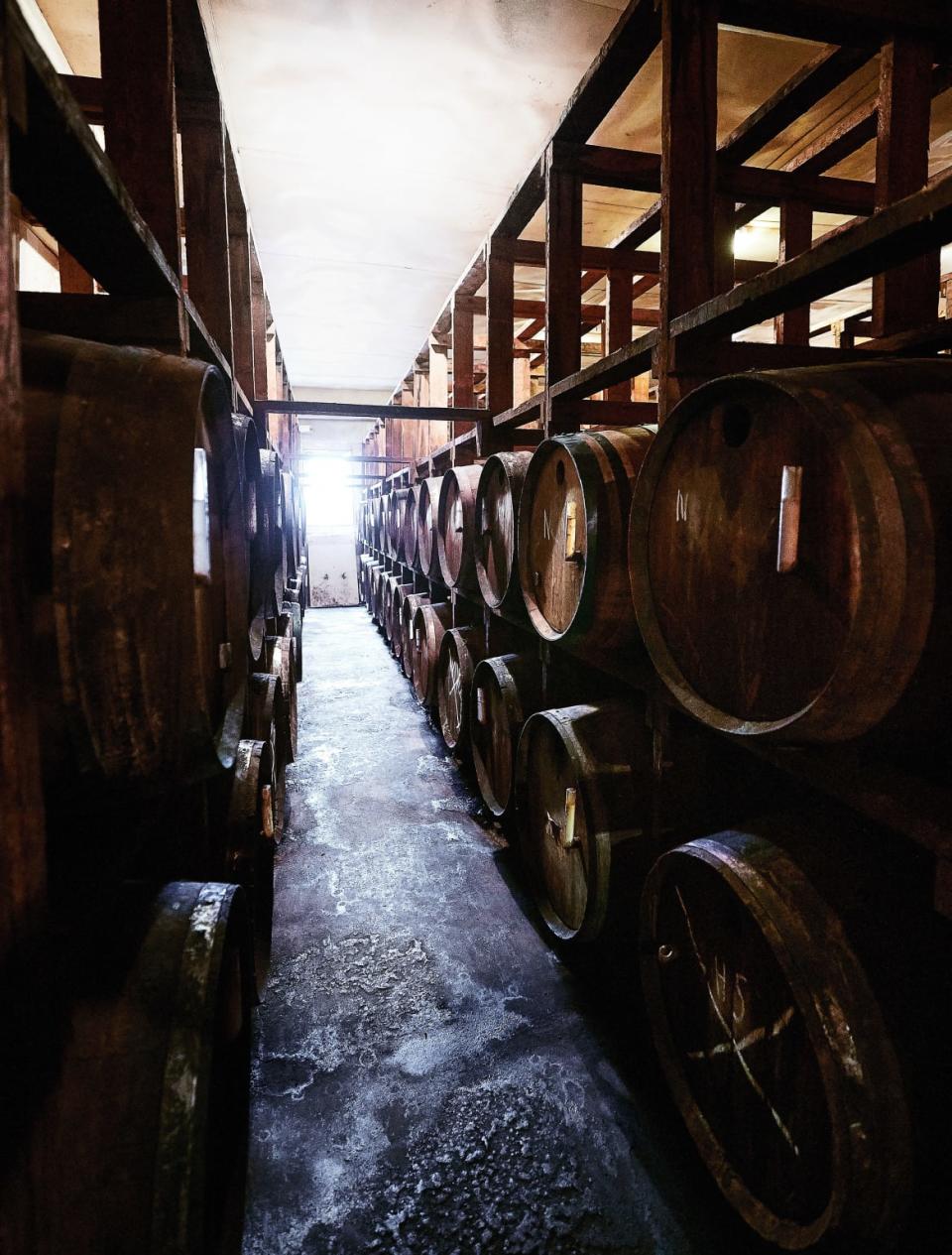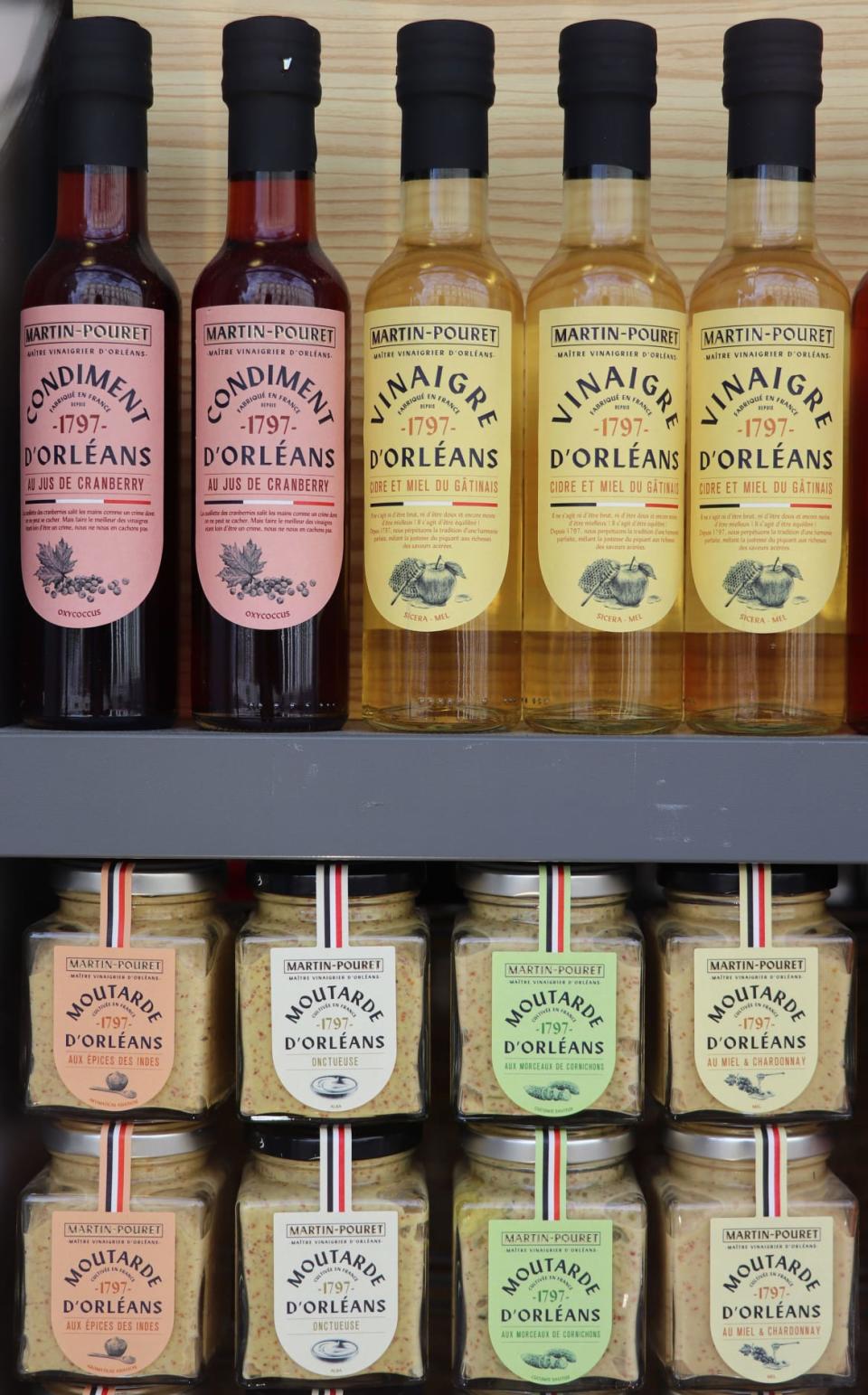I Tried the ‘Hermes of Vinegar’ and I’ll Never Go Back

ORLEANS, France—“It’s considered less sexy than winemaking.”
I’ve just entered a stuffy attic room with Paul-Olivier Claudepierre, the co-owner of the last artisanal vinegar producer in the central French city of Orléans. Hefty wooden barrels line the space, and the air is so thick with the tangy fumes of fermenting vinegar that within seconds my eyes begin to burn, and I can’t stop coughing.
We’re clad in white disposable robes with matching hairnets that resemble the unsettling result of a one-night stand between a hospital gown and a hazmat suit, and he’s giving me a tour of the Martin-Pouret factory. Situated in the Orléans suburb of Fleury-les-Aubrais, the space has been the site of the company’s vinegar production facilities since the late 18th century.
“You eventually get used to it,” Claudepierrre says to reassure me, and I nod and try to gently breathe in only to succumb to a second coughing and wheezing fit as the acidic fumes launch another assault on my lungs. I’m in too much pain to be embarrassed, and for a second I wonder if I’ll pass out.
Ironically, the source of my torment is caused by what American vinegar producer and author Reginald Smith calls “the romantic vision of vinegar making”—a centuries-old method that Smith describes in his book, Vinegar, the Eternal Condiment.
Each barrel is partially filled with wine mixed with a bacteria culture known as mother of vinegar and then left to ferment in a warm space. The heat in the room and the oxygen in the barrels encourage the fermentation process, which at Martin-Pouret takes three weeks. The vinegar then ages for a year in oak casks before it’s bottled and shipped off to clients, which comprise gourmet épiceries, iconic hotels like the Ritz Paris, and the French National Assembly.
It’s this slow process that sets Martin-Pouret apart from large industrial producers, who have swapped oak barrels for giant aluminum tanks, and can manufacture thousands of gallons of vinegar in as little as 24 hours.
Martin-Pouret’s languid approach to vinegar brewing, aptly called “the Orléans method,” has been an important part of the heritage of this small city on the banks of the Loire River even before its teenage heroine Joan of Arc led the French army in a history-making victory here in 1429 during the Hundred Years’ War. According to Smith, Orléans’s vinegar industry blossomed alongside the development of the French wine industry thanks to its strategic position on the river.

In the High Middle Ages as the country’s aristocracy expanded in wealth and power, their taste for wine ballooned along with it. Bordeaux, Loire, and other wine-producing regions sent barrels of Paris-bound wine up the Loire River on barges to Orléans—the closest riverside port city to the French capital. It was there that it was unloaded for warehousing, distribution, and, perhaps most importantly, taste-testing.
“Orléans had a large number of wine merchants, and they would usually sample the wine before sending it to their valued clients in Paris,” Smith writes. “The good wine passed and traveled on while the ‘bad’ wine was left—to turn into vinegar.”
He adds: “The vinegar, incidental at first, later became an art in and of itself.”
Such an art, that in 1394 the city’s vinegar makers formed their own guild, and, nearly two centuries later, King Henry III issued a royal decree that officially limited vinegar production to Orléans. It wasn’t long before Orléans became renowned for its artisanal vinegar, which wasn’t only used in cooking, but also in colognes (really!) and in various medicinal tinctures.
During the waning days of the French monarchy, there were about 300 vinaigreries (vinegar breweries) in Orléans. However, post-revolutionary France was less kind to the vinegar industry, and industrialization even less so. The emergence of cheap white distilled vinegar in the 19th century dealt another blow to the city’s once-lauded vinegar industry. By 1914, only 17 traditional vinegar breweries remained, and today there’s only one: Martin-Pouret, which, until recently, was run by the same family for six generations.
Enter Claudepierre, a fortysomething graduate of Paris’ prestigious ESSEC business school, who, in his navy blazer and polished dress shoes, initially appears more GQ than craft vinegar connoisseur when we first meet for lunch at a lively local brasserie. But as he recounts his professional journey from large multinational beverage groups like Carlsberg and Illy to his present post as co-owner of Martin-Pouret, his enthusiasm for his new métier is apparent.
Having teamed up with a business school buddy, Claudepierre wanted to launch a new venture and was hoping to either start a company or take over an existing luxury brand. Something clicked when he came upon Martin-Pouret, which checked all the boxes in terms of what he was looking for: small, French, and with a long-established history of crafting a local artisanal product. So Claudepierre and his classmate-turned-business partner David Matheron set out to purchase Martin-Pouret and continue the tradition of crafting, as he puts it, “the Hermès of vinegar.”
The project initially hit a snag, however, when they approached Jean-François Martin, the company’s then-owner. Martin didn’t want to sell. It was only after, as Claudepierre recalls, “a very long dinner with some very good wine” that he had a change of heart. The wine may have helped, but serendipity also appears to have played a role. Apparently, Martin was nearing retirement age and none of his children were interested in taking over the family business.

Since taking the helm in 2019, Claudepierre and Matheron have sought to bring a sophisticated and contemporary flair to the brand while remaining dedicated to time-honored production methods and regional ingredients. Among the changes the new owners made were scrapping the company’s product labels (Claudepierre describes them as “atrocious”) and replacing them with a more whimsical, vintage-style design. They also added cornichons and new vinegar flavors to their line, including black tea, poppy, and cranberry, and have set their sights on expanding into new international markets.
Their efforts seem to be paying off. The 18-strong company saw a 31 percent increase in revenues in 2021 compared with the previous year and distributed some 750,000 bottles of vinegar both within France and internationally, including to Norway, the U.S., and Japan. Plans for a second boutique in Orléans are also in the works.
There’s a tasting scheduled for later in the afternoon, but it unofficially begins over lunch when, on Claudepierre’s recommendation, I ordered the poulet cocotte—chicken and potatoes served in a cast iron pot—because the company’s traditional Orléans vinegar is used in the recipe. The flavor adds a gentle zest to the dish without being too overpowering. Next, I add a small dollop of mustard, which Martin-Pouret began producing about 15 years ago. The mustard seeds are cultivated in the Loire Valley, and the flavor is delightfully intense if you like your condiments on the sinus-clearing side.
After lunch, we stop at the Martin-Pouret boutique on rue Jeanne d’Arc that’s just down the street from the city’s famous Gothic cathedral. Inside, the warm lighting and carefully curated displays evoke a high-end pastry shop or a Parisian perfume counter. Slender bottles of vinegar line the shelves, as does an alluring array of diverse mustard flavors: honey and chardonnay, Indian spices, Espelette pepper, and fig confit, to name a few. There are also jars of cornichons in white wine vinegar, as well as a small bar area at the far end of the room that’s stocked with several mustard and vinegar taps and a neat stack of refillable rustic-chic porcelain jars.
We head to the small kitchen area attached to the back of the shop, which Claudepierre tells me is reserved for occasional small-group cooking classes centered on recipes featuring the company’s condiments. Previous culinary creations have included zucchini ricotta rolls dipped in cornichon mustard, cod filet with chorizo served on ratatouille with poppy seed vinegar, and a chocolate mousse-like dessert topped with raspberries and cranberry balsamic vinegar cream.
I start with the cornichons, which I’ve been curious about ever since I learned they’re served at the Elysée Palace. I don’t know whether it was the crispness, the gentle sweet-sour acidity of the vinegar, or the faint hint of tarragon and other spices, but after the first taste I knew I had to end any further culinary association with standard pickles.
Next, I try some of the mustards, including a tomato-based flavor that’s a bit like an epicurean version of ketchup with a slightly spicy kick. Finally, it’s on to the vinegars and I sample both a standard wine vinegar, as well as its amber-colored sibling that spends 20 years aging in oak casks. The latter is more complex with a faint hint of honey, and I’m advised to pour a couple of drops on a raw oyster, which unfortunately, aren’t included in the tasting.
We wrap things up with a cocktail made with cranberry-flavored vinegar blended with fresh strawberries and ice. The resulting sweet-sour slush evokes a strawberry daiquiri with an appealing bite to it. Still, I think it’s a bit of a stretch to call it a cocktail and keep wondering how it would taste with a dash of Caña Brava rum. Nevertheless, it could go down well during one of France’s infamous summer heatwaves and could also make an ideal daiquiri alternative for non-drinkers.

The final stop is the Martin-Pouret factory. The address has been the site of the company’s production facilities for 225 years and while its drafty interiors and urbex vibe may suggest otherwise, the current building doesn’t go quite that far back. Claudepierre tells me that this corner of the city suffered heavily during World War II, and the factory was rebuilt after its predecessor was leveled in a bombing. However, its mid-20th century incarnation will also be relegated to the annals of the city’s vinegar brewing history in a couple of years when the company decamps to a larger, newly built facility in the region.
In addition to the somewhat harrowing trip to the attic room, I also visit a large space filled with casks of aging vinegar where we bump into Christophe, the company’s master vinaigrier. I am a bit shocked to learn that in addition to extensive training followed by years honing his craft, Christophe spends hours, yes, hours in that humid room with the barrels of fermenting vinegar. Could it be true that you eventually do get used to it? Or does Christophe, in addition to his vinegar-brewing expertise, somehow possess superhuman lungs?
When the tour ends, Claudepierre sends me home with a swag bag stuffed with various products, including the presidential cornichons (yes!), and several mustards. I also leave with a bottle of the 20-year-old vinegar that’s so elegantly packaged that my French partner initially mistakes it for a rare cognac.
The cornichons last a week after my partner and young stepson get wind of them, and the mustards only slightly longer after we bring them out during lunches with friends. Full disclosure: Cooking isn’t my strong point, but the vinegars and mustards elevate even the simplest of dishes like grilled chicken filets and salads.
The vinegar brewing process may be less sexy than wine making (and harder on the lungs), but even the culinarily challenged will savor the resulting products that are leagues beyond their supermarket contemporaries. And, several weeks after my trip to Orléans, the carefully crafted condiments with a centuries-long history have become just as essential at the table as an expertly selected bottle of Bordeaux.
Get the Daily Beast's biggest scoops and scandals delivered right to your inbox. Sign up now.
Stay informed and gain unlimited access to the Daily Beast's unmatched reporting. Subscribe now.

